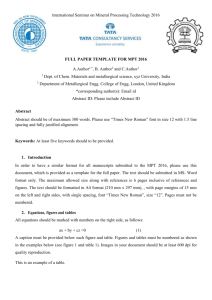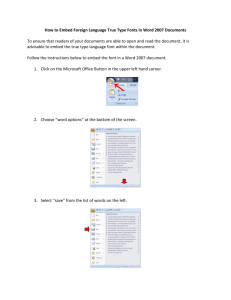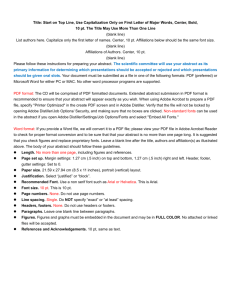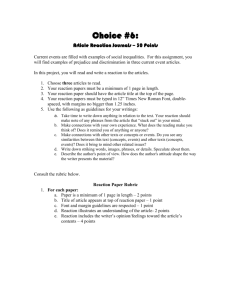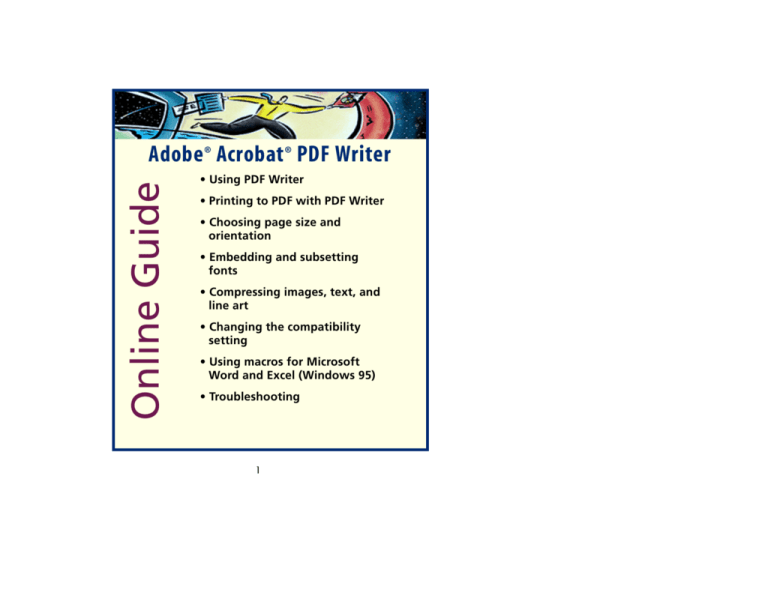
Online Guide
Adobe ® Acrobat ® PDF Writer
• Using PDF Writer
• Printing to PDF with PDF Writer
• Choosing page size and
orientation
• Embedding and subsetting
fonts
• Compressing images, text, and
line art
• Changing the compatibility
setting
• Using macros for Microsoft
Word and Excel (Windows 95)
• Troubleshooting
1
Using PDF Writer
You use PDF Writer to create a PDF file in one quick
step. After creating your original document, you
“print” to PDF with PDF Writer the same way you
print to paper, with the Print command of the
application you use to create the document.
See Printing to PDF with PDF Writer for more
information.
In most cases, you can accept PDF Writer’s default
compression and font settings. If the PDF files you
create are too large or have poor image quality, you
may want to change the default settings.
For information about changing defaults to reduce
file size, see Compressing images, text, and line art ,
Changing the compatibility setting, and Subsetting
fonts.
2
For information about changing defaults to improve
the quality of font representation and images in PDF
files, see Embedding fonts and Compressing
images, text, and line art.
Alternatively, use Acrobat Distiller to create the
PDF file. See PDF Writer or Distiller? for more
information.
3
Printing to PDF with PDF Writer
PDF Writer creates PDF files by “printing” documents
to a file when you select the Print command from
your application.
Using PDF Writer in Windows
Using PDF Writer on the Macintosh
Choosing PDF Writer options
4
Using PDF Writer in Windows
You can use PDF Writer to create a PDF file from
almost any application in Windows 3.1 and later,
Windows 95, and Windows NT 3.5.1. (not available
for Windows NT 4.0).
To create a PDF document:
1 Start your application, and open the document to be
converted to a PDF file.
2 Choose File > Print.
3 Follow the instructions for your Windows version:
• In Windows 3.1 and later and Windows NT 3.5.1,
select Acrobat PDF Writer on DISK from the Specific
Printer menu and click Print.
• In Windows 95, select Acrobat PDF Writer from the
Printer name menu and click OK.
5
4 Select the destination directory, enter a name for the
PDF file, and click OK. The Document Info dialog box
appears.
5 Fill in the appropriate information, and click OK.
The PDF file is created, and you are returned to
your application.
6
Using PDF Writer on the Macintosh
You can use PDF Writer to create a PDF file from
almost any application on a Macintosh.
To create a PDF document:
1 Start your application, and open the document to be
converted to a PDF file.
2 Do one of the following:
• Hold down the shortcut key (the Control key by
default) while choosing File > Print. See Using the PDF
Writer Shortcut for more information.
• Open the Chooser, and select the PDF Writer printer
driver. Close the Chooser, return to your application,
and choose File > Print.
7
3 Enter the page range, and click OK. The Document
Info dialog box appears. Fill in the appropriate information, and click OK.
4 Name the PDF file with the extension .pdf, choose the
destination directory, and click Save. The PDF document
is created, and you are returned to your application.
8
Using the PDF Writer Shortcut
With the shortcut installed, you can invoke PDF
Writer without selecting it in the Chooser. To do
this, you press the shortcut key (the Control key by
default) when choosing the Page Setup or Print
command.
Your previously selected printer driver is reselected
after the PDF file is saved to disk.
You can change the shortcut key in the PDF Writer
Shortcut Control Panel under the Apple menu.
9
Choosing PDF Writer options
When you “print” with PDF Writer, you can select
options in the Save As dialog box (Windows) or the
PDF Writer dialog box (Macintosh):
• View PDF File opens the PDF document in an
Acrobat viewer immediately after creating the document.
• Prompt for Document Info displays the General
Information dialog box. You can enter the document’s
title (as opposed to the PDF filename), subject, author,
and keywords. The option is not available if the View
PDF File option is selected.
• Short (DOS) Filenames (Macintosh) truncates
the filename in the PDF Writer dialog box to an 8.3
DOS filename.
10
Choosing page size and orientation
You can choose from a list of standard page sizes
or enter values for a custom page size. The default
is 8 1/2-by-11 inches. The minimum page size
allowed in a PDF file is 1-by-1 inch. The maximum
is 45-by-45 inches.
You can also choose either portrait or landscape
page orientation. The orientation and page size
that you choose are displayed in the PDF Writer
Options (Windows) or the Page Setup (Macintosh)
dialog box.
To choose page size and orientation:
1 Start your application, and open the document to
be converted to a PDF file.
2 Follow the instructions for your platform:
• In Windows 3.1 and later and Windows NT 3.5.1,
choose File > Print Setup. Select Acrobat PDF Writer on
DISK from the Specific Printer menu; choose Options.
11
• In Windows 95, choose File > Print (Printer Setup in
some applications). Select Acrobat PDF Writer from the
Printer menu, and click Properties (or Setup in some
applications).
• On the Macintosh, hold down the shortcut key (the
Control key by default) while choosing File > Page Setup.
3 To change the orientation, click the portrait or landscape icon.
4 To change the page size, do one of the following:
• Click Standard, and select the page size of your
document from the menu.
• Click Custom, and enter the page dimensions and
margins. Choose a unit of measurement from the
Custom Page Size menu.
12
5 In Windows, accept or change the resolution setting
on the menu. This setting determines the resolution at
which the file is sent to a printer and can sometimes
alter character spacing. For best results, use the resolution setting of the printer chosen when the original file
was created. To reduce the size of the PDF file significantly, reduce the resolution setting.
6 Click OK when the page setup is complete.
13
Embedding and subsetting fonts
Using PDF Writer, you can embed TrueType and
Type 1 fonts in PDF files. For Acrobat viewers on
computers that do not have the fonts installed, the
alternative is to display and print substitute fonts
instead.
Subsetting embedded fonts reduces file size
by embedding only those characters used in a
document.
On the Macintosh, Adobe Type Manager (ATM)
must be installed at the system level for PDF Writer
to embed Type 1 fonts. See How ATM works with
Macintosh Acrobat viewers for more information.
See About Fonts for general font information.
Embedding fonts
Subsetting fonts
14
Embedding fonts
By default, PDF Writer embeds display-face fonts
that would lose their unique characteristics if they
were substituted for in the Acrobat viewers or at the
printer. You can embed any other fonts except the
Base 13. On a Macintosh, you can rebuild the font
list to ensure that any font on the system that you
might want to embed is available to PDF Writer.
To embed fonts:
1 Follow the instructions for your platform:
• In Windows 3.1 and later and Windows NT 3.5.1,
choose File > Print Setup. Select Acrobat PDF Writer on
DISK from the Specific Printer menu; click Options; click
Fonts.
• In Windows 95, choose File > Print (Printer Setup in
some applications). Select Acrobat PDF Writer from the
Printer menu, click Properties (or Setup in some applications), and click Fonts.
15
• On a Macintosh, hold down the shortcut key (the
Control key by default) while choosing File > Page Setup;
click Fonts.
2 Choose one of the following:
• To embed all fonts used in a document, click Embed
All Fonts and click OK.
• To embed specific fonts, click Always Embed, select
the fonts that you want to embed, and either drag them
to the Always Embed list or click Add; then click OK.
• To embed all but some specific fonts, click Embed All
Fonts, select the fonts that you do not want to embed,
and either drag them to the Never Embed list or click
Add; then click OK.
16
To remove a typeface from the Always Embed or
Never Embed list, highlight the typeface and click
Remove, or simply drag the font to the Available
Fonts list. When you remove a display face from the
Always Embed list, it will be added to the list again
if you rebuild the font list or reinstall PDF Writer.
Important: You may need permission from the
font supplier to distribute PDF files containing
other embedded fonts.You may embed Adobe
Originals and fonts owned by Linotype-Hell AG,
International Typeface Corporation, Agfa-Gevaert,
Fundición Typográfica Neufville, and Monotype
Typography, Ltd., which are available from the
Adobe Type Library.
17
Rebuilding the font list (Macintosh)
Click Rebuild in the PDF Writer Fonts dialog box to
ensure that all fonts on the system are available to
PDF Writer. Click the Defaults button to reinstate the
original PDF Writer settings.
The original PDF Writer settings include adding
some Adobe script and symbol display faces to
the Always Embed list if they are installed on
the computer.
18
Subsetting fonts
Font subsetting contributes to smaller PDF files by
including only the characters in the font that are
used in a document. When font embedding and subsetting options are chosen, subsetting will occur if
less than 35% of the characters in a font are used in
a document. If the character percentage threshold
exceeds 35%, then the entire font is embedded.
You can’t change the character threshold percentage
in PDF Writer. If you need more control over the
percentage setting, use Acrobat Distiller.
When you combine PDF files with the same font subset, the subsets are not combined. As a result, combining files with subsetted fonts may result in a
large file
Note: Standard roman fonts contain 256 characters, 35% of a roman font is approximately 90
characters.
19
The compatibility setting chosen determines how
certain font formats are subsetted. TrueType fonts
can be subsetted if either Acrobat 2.1 or Acrobat 3.0
compatibility settings are chosen. Type 1 fonts can
be subsetted only with a Acrobat 3.0 compatibility
setting. You can identify font type in the PDF Writer
Font Embedding dialog box.
Type 1 fonts have the Type 1 icon next to the
font name.
TrueType fonts have the TrueType icon next to
the font name.
To subset fonts:
1 With either Embed All or Always Embed selected in
the PDF Writer Fonts dialog box, follow the instructions
for your platform:
• In Windows 3.1 and later and Windows NT 3.5.1,
choose File > Print Setup. Select Acrobat PDF Writer
on DISK from the Specific Printer menu; click Options;
click Fonts.
20
• In Windows 95, choose File > Print (Printer Setup in
some applications). Select Acrobat PDF Writer from the
Printer menu, click Properties (or Setup in some applications), and click Fonts.
• On a Macintosh, hold down the shortcut key (the
Control key by default) while choosing File > Page Setup;
click Fonts.
2 Select Embed All Fonts or Always Embed.
3 Select Subset Type 1, Subset TrueType, or both. (If
you are using the Acrobat 2.1 compatibility default,
you can subset only TrueType fonts.)
21
Compressing images, text, and line art
By default, PDF Writer compresses bitmap images,
text, and line art, and it further reduces file size by
downsampling high-resolution bitmap images.
Color and grayscale images can be extremely large.
If file size is not an issue, you can remove compression or downsampling. You can also change the
default compression settings for specific purposes.
Changing compression settings
Changing the downsampling setting
22
Changing compression settings
In most cases, the PDF Writer default compression
settings create an acceptably small PDF file. The
default PDF Writer settings are the following:
• Binary format
• Compress text and line art
• Compress color and grayscale images with the
JPEG – Medium compression method
• Compress monochrome images with the CCITT
Group 4 compression method
• Acrobat 2.1 compatibility
If you need more control over the image quality
or file size, change the PDF Writer compression
options.
23
To change a compression setting:
1 Follow the instructions for your platform:
• In Windows 3.1 and later and Windows NT 3.5.1,
choose File > Print Setup. Select Acrobat PDF Writer on
DISK from the Specific Printer menu, click Options, and
click Compression.
• In Windows 95, choose File > Print (Printer Setup in
some applications). Select Acrobat PDF Writer from the
Printer menu, click Properties (or Setup in some applications), and click Compression.
• On the Macintosh, hold down the shortcut key (the
Control key by default) while choosing File > Page Setup;
click Compression.
2 Choose a compression option. Deselecting an option
tells PDF Writer not to apply that type of compression.
24
3 Select a compression method from the pop-up menu.
PDF Writer provides ZIP compression with Acrobat 3.0
compatibility and LZW compression with 2.1 compatibility as the lossless method of compression for text
and line art, and for color, grayscale, and monochrome
images.
To restore the default settings:
With the PDF Writer Compression dialog box open,
click Defaults.
See About compression for more information about
individual compression methods.
25
Changing the downsampling setting
Downsampling reduces resolution by averaging the
pixel color of a sample area and replacing that area
with a pixel of the averaged color. PDF Writer automatically downsamples images in the following
manner:
• Color images are downsampled to 96 (Windows) or
72 (Macintosh) dpi.
• Grayscale images are downsampled to 96 (Windows)
or 150 (Macintosh) dpi.
• Monochrome images are downsampled to 300
(Windows and Macintosh) dpi.
You cannot alter the downsampling resolution setting in PDF Writer. If you need more control over
downsampling images, use Acrobat Distiller. See
About image downsampling and subsampling for
more information.
26
To change the downsampling setting:
1 Follow the instructions for your platform:
• In Windows 3.1 and later and Windows NT 3.5.1,
choose File > Print Setup. Select Acrobat PDF Writer on
DISK from the Specific Printer menu, click Options, and
click Compression.
• In Windows 95, choose File > Print (Printer Setup in
some applications). Select Acrobat PDF Writer from the
Printer menu, click Properties (or Setup in some applications), and click Compression.
• On the Macintosh, hold down the shortcut key (the
Control key by default) while choosing File > Page Setup;
click Compression.
2 Select or deselect the Downsample Images option.
3 Click OK.
27
Changing the compatibility setting
Acrobat Distiller 3.0 offers you two choices for
compatibility, Acrobat 2.1 and Acrobat 3.0. PDF files
cannot be opened in Acrobat 2.1 or earlier viewers
if those files were created with Acrobat 3.0 compatibility and either of the following compressed text
and line art or embedded Type 1 fonts.
Choosing 3.0 compatibility takes advantage of a
number of 3.0 improvements. However, unless you
know that all the recipients of your PDF documents
have 3.0 viewers, you should use Acrobat 2.1 compatibility during the upgrade period to ensure file
access. See the compatibility comparison chart for
details on 2.1 and 3.0 compatibility.
28
To change the compatibility setting:
1 Follow the instructions for your platform:
• In Windows 3.1 and later and Windows NT 3.5.1,
choose File > Print Setup. Select Acrobat PDF Writer on
DISK from the Specific Printer menu, click Options, and
click Compression.
• In Windows 95, choose File > Print (Printer Setup in
some applications). Select Acrobat PDF Writer from the
Printer menu, click Properties (or Setup in some applications), and click Compression.
• On the Macintosh, hold down the shortcut key (the
Control key by default) while choosing File > Page Setup;
click Compression.
2 Select a compatibility setting, and click OK.
29
The following table illustrates the difference in
features available when choosing 2.1 or 3.0
compatibility.
Acrobat 2.1
Acrobat 3.0
Uses LZW compression
Uses ZIP compression
No font compression
Compresses fonts
Subsets TrueType only
Subsets Type 1 and
TrueType
PDF files opened by
Acrobat viewers 3.0
and earlier
PDF files opened by
Acrobat viewers 3.0
and later
30
Using macros for Microsoft Word
and Excel (Windows 95)
Macros for Word and Excel add a Create Adobe PDF
command to the File menus of those applications.
Choosing the Create Adobe PDF command automatically switches to the PDF Writer driver, creates the
PDF file, and then switches back to the previously
selected printer driver.
The macros are automatically installed when PDF
Writer is installed. Pdfwrite.xla is installed in Excel’s
XLStart directory. Pdfwrite.dot is installed in Word’s
Startup directory. These files can also be found in
the Acrobat3\Exchange\Macros directory.
31
1996 Adobe Systems Incorporated. All rights reserved.
Adobe Acrobat 3.0 PDF Writer Online Guide
This manual, as well as the software described in it, is furnished under license
and may be used or copied only in accordance with the terms of such license.
The content of this manual is furnished for informational use only, is subject to
change without notice, and should not be construed as a commitment by Adobe
Systems Incorporated. Adobe Systems Incorporated assumes no responsibility
or liability for any errors or inaccuracies that may appear in this book.
The copyrighted software that accompanies this manual is licensed to the End
User for use only in strict accordance with the End User License Agreement,
which the Licensee should read carefully before commencing use of the software. Except as permitted by such license, no part of this publication may be
reproduced, stored in a retrieval system, or transmitted, in any form or by any
means, electronic, mechanical, recording, or otherwise, without the prior written permission of Adobe Systems Incorporated.
Adobe, the Adobe logo, Acrobat, Acrobat Capture, the Acrobat logo, Distiller,
Acrobat Exchange, Adobe Type Manager, PostScript, and the tagline “If you can
dream it, you can do it” are trademarks of Adobe Systems Incorporated.
Microsoft and Windows are registered trademarks and ActiveX and Windows NT
are trademarks of Microsoft Corporation in the U.S. and other countries. Apple,
Macintosh, Power Macintosh, and QuickTime are registered trademarks and
AppleScript and TrueType are trademarks of Apple Computer, Inc. Lotus Notes
is a registered trademark of Lotus Development Corporation. Netscape and
Netscape Navigator are trademarks of Netscape Communications Corporation.
UNIX is a registered trademark in the U.S. and other countries, licensed exclusively through X/Open Company, Ltd. Pentium is a trademark of Intel Corporation. All other products or name brands are trademarks of their respective
owners.
This product contains an implementation of the LZW algorithm licensed under
U.S. Patent 4,558,302.
32
This software includes software licensed from Verity, Inc., copyright 1994. All
rights reserved. The address of Verity, Inc., is 894 Ross Drive, Sunnyvale, California 94089. Verity ® and TOPIC ® are registered trademarks of Verity, Inc. in
the United States and other countries. English Electronic Thesaurus copyright
1993 by INSO Corporation. Adapted from the Oxford Thesaurus copyright 1991
by Oxford University Press and from Roget's II: The New Thesaurus copyright
1980 by Houghton Mifflin Company. All rights reserved. Reproduction or disassembly of embodied programs and databases prohibited.
1994 This software includes software licensed from RSA Data Security, Inc.
Written and designed at Adobe Systems Incorporated, 345 Park Ave., San Jose,
CA 95110-2704.
Adobe Systems Europe Limited, Adobe House, 5 Mid New Cultins, Edinburgh
EH11 4DU, Scotland, United Kingdom
Adobe Systems Co., Ltd., Yebisu Garden Place Tower, 4-20-3 Ebisu, Shibuya-ku,
Tokyo 150, Japan
For defense agencies: Restricted Rights Legend. Use, reproduction, or disclosure
is subject to restrictions set forth in subparagraph (c)(1)(ii) of the Rights in Technical Data and Computer Software clause at 252.227-7013.
For civilian agencies: Restricted Rights Legend. Use, reproduction, or disclosure
is subject to restrictions set forth in subparagraphs (a) through (d) of the commercial Computer Software Restricted Rights clause at 52.227-19 and the limitations set forth in Adobe’s standard commercial agreement for this software.
Unpublished rights reserved under the copyright laws of the United States.
(9/96)
33
How to use this online guide
Page back or page forward.
Undoes a change of page or view, or redoes a
change (Go Back/Go Forward).
Go to the Contents.
Go to the Index.
Go to the how-to page (this page).
Go to the “parent” of the current topic.
text
Go to the indicated topic.
Go to the next page of a continued topic.
End of a continued topic.
For instructions on printing this guide, go to the next page.
34
How to print this online guide
You can print separate topics or the entire guide.
Since the pages of the guide have been made small
for online viewing, Windows and Macintosh users
may prefer to print them two to a page of paper—
”two up.”
To print pages two up:
1 Choose File > Print Setup (Windows) or File > Page
Setup (Macintosh).
2 Follow the instructions for your platform:
• In Windows, click Options, select 2 up on the Paper
tab, click OK to return to the Print Setup dialog box, and
click OK again to close it.
35
• On a Macintosh, choose 2 Up from the Layout menu
and click OK.
Note: If you can’t perform step 2, you may not be
using an Adobe or PostScript printer driver. If you
are and you still can’t perform the step, install the
Adobe printer driver on the Acrobat CD-ROM. See
the Acrobat Getting Started guide for installation
instructions.
3 Choose File > Print.
4 Indicate the page range.
Click OK (Windows) or Print (Macintosh).
36


